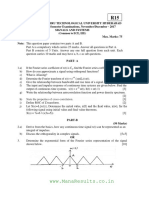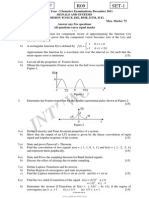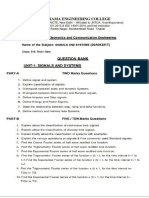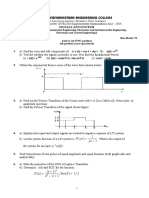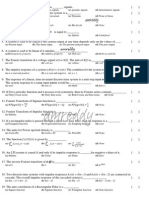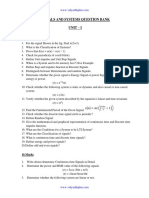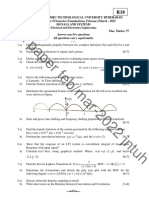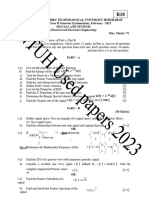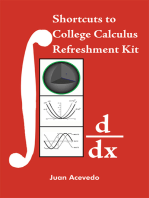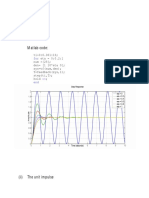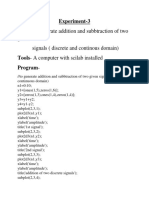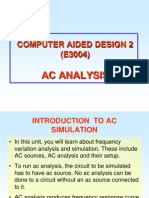Assignment Questions
Uploaded by
sudhamaniAssignment Questions
Uploaded by
sudhamaniCMR TECHNICAL CAMPUS
Kandlakoya(V), Medchal Road, Hyderabad – 501 401
Assignment Questions
Department of ECE
1. (a) Discuss the concept of orthogonality in complex functions and derive the expression
for component vector of approximating the function f1(t) over f2(t) in case of complex
functions.
(b) Prove that complex exponential signal space is an orthogonal signal space
2. Find whether the following signals are energy or power or neither
(i) x(t)= e-5t u(t) (ii) x(t)= t2 u(t) (iii) x(t) =2u(t) – u(t-3)
(iv) x(n) = r(n) – r(n-4) (v) x(n)= cos(πn/4)
3. Bring out the relationship between trigonometric Fourier series and Exponential Fourier
series. Find exponential Fourier series for a signal x (t)=4+ 3 cost+ 3 sin 4 t in the interval
(0,2π).
4. Define Fourier transform, state its properties and prove Parseval’s Theorem, differentiation
in time domain, Time shifting and Symmetry in complex signals
5. What is a system? Classify systems and Explain in detail about linearity and time
invariance properties of a system with one example each.
6. (a) Explain the concept of Paley-Wiener criterion for physical realizability using relevant
expressions.
(b) Obtain the relationship between the bandwidth and rise time of ideal low pass filter..
7. (a) Define and state the properties of ROC of Laplace Transform.
(b) Obtain inverse Laplace transform of the following s-domain signals:
3 s +7 −3
(i) X ( s ) = 2 (ii) X ( s ) =
s −2 s−3 ( s+2 )(s−1)
8. (a) Define and state the properties of ROC of Laplace Transform.
(b) Obtain inverse Laplace transform of the following s-domain signals:
3 s +7 −3
(i) X ( s ) = 2 (ii) X ( s ) =
s −2 s−3 ( s+2 )(s−1)
9. (a) State sampling theorem for band-limited signals. Draw the spectrum for all frequencies.
(b) Determine the Nyquist sampling rate and Nyquist sampling interval of
(i) X(t) = 2sinc(100Πt) (ii) X(t)= (1/2) sinc(150Πt) +(1/3)sinc(50Πt)
10. a) Prove that autocorrelation function and energy spectral density function forms a
Fourier transform pair.
b) Determine the autocorrelation function and energy spectral density function of
x(t) = e-at u(t)
11. (a) Define Convolution.
(b) Find the convolution of two functions and represent them graphically.
X(t) = 2 for -2≤t≤2 and h(t) = 4 for 0≤t≤2
= 0 otherwise = 0 otherwise
12 (a) Explain the concept of Paley-Wiener criterion for physical realizability using relevant
expressions.
(b) Explain the filter characteristics of ideal LPF, HPF and BPF using their magnitude and
phase responses.
13 (a) Obtain the conditions for distortion less transmission through a system.
(b) Obtain the relationship between the bandwidth and rise time of ideal low pass filter.
14 (a) Define and state any six properties of Laplace Transform.
(b) Bring out the relationship between Laplace and Fourier Transform.
15 (a) Define and State the properties of ROC of Laplace transform
(b) Determine the Laplace transform and ROC of i) f(t) = e-at sin(wt) ii) f(t) = e-at cosh(wt)
16 (a) Find the Z-transform and ROC of the discrete signal x[n] = n[3(2n) -4(3n )]u[n].
1 −1
z
4
(
(b) Given H z = ) find h(n) for ROC (i) |z|>1/2 (ii) |z|<1/4 (iii) 1/4 <|
( 1 −1
1− z
2 )( 1 −1
1− z
4 )
z|<1/2
17(a) The signal g(t) = 10 cos(20πt) cos(200πt) is sampled at the rate of 250 samples per second.
What is the Nyquist rate for g (t) as a low-pass signal and determine the lowest permissible
sampling rate for this signal?
(a) What is Aliasing? Explain in detail with spectral details of a sample data.
(b) Explain about nyquist rate of sampling.
18(a) Prove that autocorrelation function and energy spectral density function forms a Fourier
transform pair.
b) Determine the autocorrelation function and energy spectral density function of
x(t) = e-at u(t)
19 (a) Compare impulse sampling, Natural Sampling and Flat Top Sampling methods in
detail
(b) The signal X(t) =cos(5Πt) + 0.3cos(10Πt) is instantaneously sampled. The interval
between the samples is Ts. Find the maximum allowable value for Ts, to reconstruct the
signal Vs(t) is passed through a rectangular LPF. Find the minimum filter bandwidth to
reconstruct the signal without distortion.
20. Check whether the systems given below are linear and Time invariant or not?
d
(i) y ( t ) = x (t ) (ii) y ( n )=x ( 4−n )+ x (n−1) (iii) y ( t ) =e x(t ) iv) y(n)=log(sin(n)).
dt
You might also like
- Jntuk - B Tech - 2018 - 3 1 - Reg Supple - r16 r13 r10 - Eee - r1631023112018 Signals and Systems100% (1)Jntuk - B Tech - 2018 - 3 1 - Reg Supple - r16 r13 r10 - Eee - r1631023112018 Signals and Systems4 pages
- RADAR Signal Data Acquisition, Conditioning & Processing SystemNo ratings yetRADAR Signal Data Acquisition, Conditioning & Processing System27 pages
- WWW - Manaresults.Co - In: (Common To Ece, Eie)No ratings yetWWW - Manaresults.Co - In: (Common To Ece, Eie)2 pages
- Systems and Signals Laplace Transform PracticeNo ratings yetSystems and Signals Laplace Transform Practice4 pages
- WWW - Manaresults.Co - In: Signals and SystemsNo ratings yetWWW - Manaresults.Co - In: Signals and Systems4 pages
- R13 - December, 2014 - Regular ExaminationsNo ratings yetR13 - December, 2014 - Regular Examinations3 pages
- 2022 Set B PYQ Paper - Digital Signal Processing PYQ Paper For Sem V Uploaded by Navdeep Raghav (DU Academic Corner)No ratings yet2022 Set B PYQ Paper - Digital Signal Processing PYQ Paper For Sem V Uploaded by Navdeep Raghav (DU Academic Corner)4 pages
- X-ray Absorption Spectroscopy for the Chemical and Materials SciencesFrom EverandX-ray Absorption Spectroscopy for the Chemical and Materials SciencesNo ratings yet
- CMR Technical Campus: Dept. of Electronics & Communication EngineeringNo ratings yetCMR Technical Campus: Dept. of Electronics & Communication Engineering4 pages
- CMR Technical Campus: Dept. of Electronics & Communication EngineeringNo ratings yetCMR Technical Campus: Dept. of Electronics & Communication Engineering5 pages
- (I) The Unit Step Matlab Code:: Problem - 1No ratings yet(I) The Unit Step Matlab Code:: Problem - 16 pages
- Given Signals (Discrete and Continous Domain) : Experiment-3 Aim-To Generate Addition and Subbtraction of TwoNo ratings yetGiven Signals (Discrete and Continous Domain) : Experiment-3 Aim-To Generate Addition and Subbtraction of Two3 pages
- Horn and Driver Upgrades: For The KlipschornNo ratings yetHorn and Driver Upgrades: For The Klipschorn15 pages
- Image Registration, Deformation, and Enhanced Contouring For Radiotherapy With MIM MaestroNo ratings yetImage Registration, Deformation, and Enhanced Contouring For Radiotherapy With MIM Maestro16 pages
- Digital Signal Processing Question PaperNo ratings yetDigital Signal Processing Question Paper2 pages
- Lecture 050 - All-Digital Phase Lock Loops (Adplls)No ratings yetLecture 050 - All-Digital Phase Lock Loops (Adplls)20 pages
- EML4314C (Fall (2014 ( (Exam (1 ( (October (16, (2014 ( ( (: Grading KeyNo ratings yetEML4314C (Fall (2014 ( (Exam (1 ( (October (16, (2014 ( ( (: Grading Key6 pages
- MAGMAP Filtering: Montaj Extension Developed by GeosoftNo ratings yetMAGMAP Filtering: Montaj Extension Developed by Geosoft2 pages
- Computer Aided Design 2 (E3004) : Ac AnalysisNo ratings yetComputer Aided Design 2 (E3004) : Ac Analysis14 pages
- Low Cost Prototype Simulation of Spectrum Analyzer Base On GNU Radio and RTL-SDRNo ratings yetLow Cost Prototype Simulation of Spectrum Analyzer Base On GNU Radio and RTL-SDR13 pages





